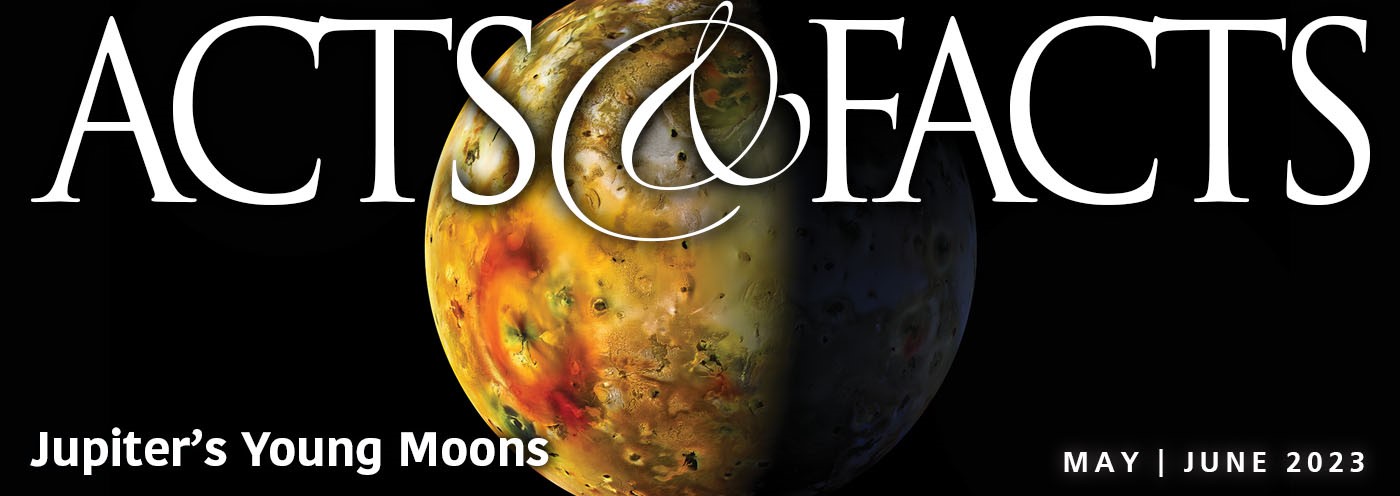On June 7, 2021, NASA’s Juno spacecraft flew closer to Jupiter’s moon Ganymede than any spacecraft had ever before. Ganymede is the largest moon in the Solar System—a body larger than the planet Mercury. Its frozen surface holds interest as a distant water source. Analysts still ponder three unique features of Ganymede, one of which they’re now seeing for the first time. If reactions to youthful features on other bodies out there offer any lesson, then long-age believers will end up once again wrestling with why this moon also looks young.
Juno’s newly released image records only the green part of the spectrum, which NASA rendered in grayscale. Red and blue are on the way and, after processing, should result in a full-color image of Ganymede’s surface. But this green channel is enough to reveal what look like fissures.
A NASA web post that accompanied Juno’s new image noted “long structural features possibly linked to tectonic faults.”1 And faults imply geologic activity, which of course requires energy. If these faults turn out to look like recently formed features, will uniformitarian thinkers craft tales to keep this moon’s geology energized over billions of years? That’s what happened with Earth’s Moon2 and with Pluto.3 If over 4 billion years old, then shouldn’t these bodies all be geologically dead many times over?
NASA scientists have also trained the Hubble telescope onto Ganymede. A newer analysis of 1998 observations revealed water vapor in its atmosphere. Their 2021 report in the journal Nature Astronomy described a process where just enough sunlight hits the equator to vaporize surface ice.4 Lead author Lorenz Roth told NASA, “The water vapor that we measured now originates from ice sublimation caused by the thermal escape of water vapor from warm icy regions.”5 Can ice keep getting sublimated off the moon’s surface for billions of years? Other Solar System bodies are also losing water into space at rates that make them look young.6,7
And like so many unexpected discoveries of still-active magnetic fields in Solar System planets and moons, those 1998 spectra revealed electrified gas bands that “provided further evidence that Ganymede has a weak magnetic field.”3 But it shouldn’t have any magnetic field at all!
A 2015 summary noted Ganymede’s magnetic field strength as higher than Mercury’s and as “a bit of a mystery” because “it should have cooled sufficiently that fluid motions are no longer possible.”8 A century ago, uniformitarian scientists proposed a dynamo theory to explain how the magnetic fields of moons and planets could persist for billions of years.9 This theory requires such bodies to have molten cores. But such cores should have cooled and frozen eons ago, so that bodies like Mercury and Ganymede should no longer have magnetic fields. Yet they do!
Magnetic fields decay like spinning tops. These magnetic fields can’t last billions of years, but they could last thousands of years, even without a dynamo. Since the Lord Jesus created this moon along with its decaying magnetosphere just thousands of years ago, as indicated by Scripture, this mystery disappears.
Magnetism, sublimation, and possible tectonic faulting give Ganymede hallmarks of youth. These three features promise to pose a glitch for old-age thinking but fit recent creation without a hitch.
References
1. See the First Images NASA’s Juno Took As It Sailed by Ganymede. NASA. Posted on nasa.gov June 8, 2021, accessed August 2, 2021.
2. Watters, T. R. et al. 2010. Evidence of Recent Thrust Faulting on the Moon Revealed by the Lunar Reconnaissance Orbiter Camera. Science. 329 (5994): 936-940.
3. At Pluto, New Horizons Finds Geology of All Ages, Possible Ice Volcanoes, Insight into Planetary Origins. New Horizons News Center. Posted on pluto.jhuapl.edu November 9, 2015, accessed August 2, 2021.
4. Roth, L. et al. A sublimated water atmosphere on Ganymede detected from Hubble Space Telescope observations. Nature Astronomy. Posted online before print, July 26, 2021.
5. Hubble finds first evidence of water vapor at Jupiter’s moon Ganymede. NASA. Posted on hubblesite.org July 26, 2021, accessed August 2, 2021.
6. Cassini Spacecraft Reveals 101 Geysers and More on Icy Saturn Moon. Jet Propulsion Laboratory. Posted on jpl.nasa.gov July 28, 2014, accessed August 3, 2014.
7. Bauer, M. Rosetta Arrives at Comet Destination. European Space Agency. Posted on esa.int August 6, 2014, accessed August 6, 2014.
8. Williams, M. Jupiter's moon Ganymede. Physorg. Posted on phys.org/news October 15, 2015, accessed August 3, 2021.
9. Humphreys, D. R. 2013. Planetary Magnetic Dynamo Theories: A Century of Failure. Proceedings of the Seventh International Conference on Creationism. Pittsburgh, PA: Creation Science Fellowship.
Dr. Brian Thomas is Research Scientist at the Institute for Creation Research and earned his Ph.D. in paleobiochemistry from the University of Liverpool.
Does Ganymede Look Young?
The Latest
Liberty and the Word of God
“And I will walk at liberty: for I seek thy precepts” (Psalm 119:45).
July 4th is called Independence Day here in our country because on...
July 2025 ICR Wallpaper
"These things I have spoken to you, that in Me you may have peace. In the world you will have tribulation; but be of good cheer, I have overcome...
Valued Longtime ICR Employee Mary Smith Retires
Mary Morris Smith, an employee of the Institute for Creation Research for many years, has retired. The second daughter of ICR founder Dr. Henry M. Morris...
Man of Science, Man of God: George Washington Carver
Who: George Washington Carver
What: Father of Modern Agriculture
When: 1864 or 1865 – January 5, 1943
Where: Diamond Grove,...
The Scopes Monkey Trial: A Battle of Worldviews
Rhea County Courthouse in Dayton, Tennessee, and its statue of William Jennings Bryan
Image credit: M. Mueller
The Scopes Monkey...
Long Non-Coding RNAs: The Unsung Heroes of the Genome
Evolutionary theory holds that all living things came about through random, natural processes. So conventional scientists believe the genome has developed...
Yosemite National Park, Part 1: Tiny Clues of a Grand Picture
Yosemite National Park in California is a sure source of stunning scenery. It’s no wonder that American naturalist John Muir persuaded President...
From Inference to Theory: A Common Design Case Study
Without a doubt, humans, chimpanzees, and other organisms share similar features. An early explanation was that these features reflect similar designs...
Creation Kids: T. rex
by Michael Stamp and Susan Windsor*
You're never too young to be a creation scientist and explore our Creator's world. Kids, discover...
Entering By The Door
Recently, I hosted a visiting pastor from a large church at ICR’s Discovery Center. As I guided him through our Dallas museum, one conversation...















